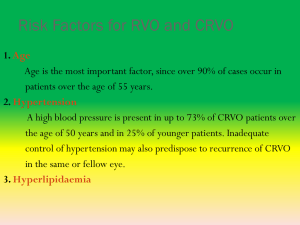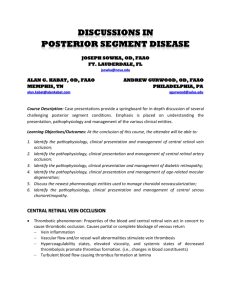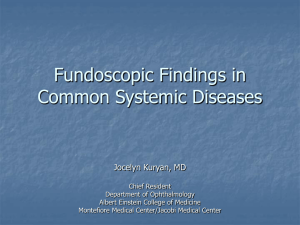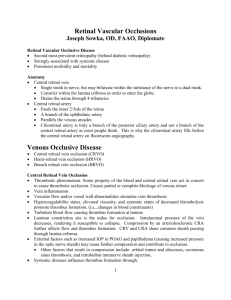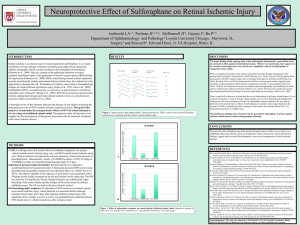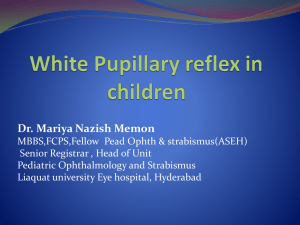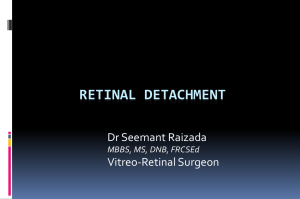Central Retinal Vein Occlusion (Powerpoint)
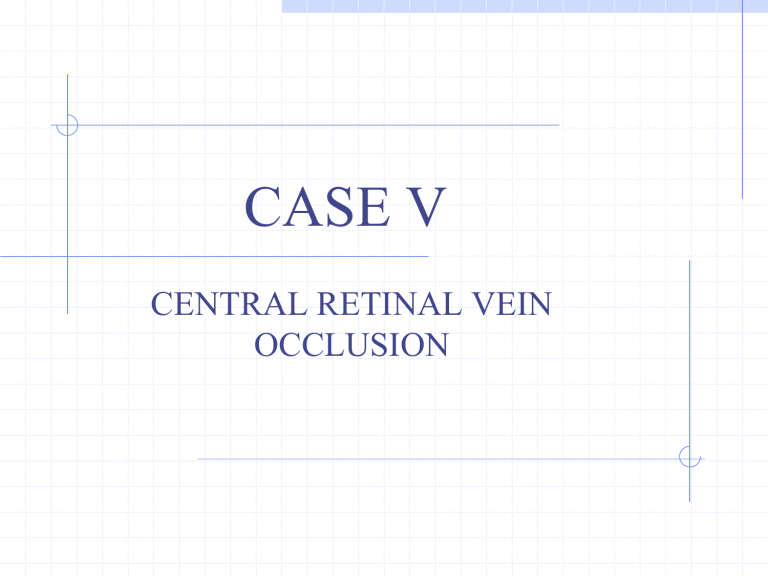
CASE V
CENTRAL RETINAL VEIN
OCCLUSION
Patient History; 52yo female
Cc: Colorless, gray spot interfering with vision, OS. Began this morning, comes and goes.
Pt reports no loss of vision, or flashing lights, OU.
Pt being followed by PCP for fatigue,
‘loopiness’. Possible DM. Blood work ordered.
Examination Results, I
VA- 20/20 OU.
PERRL (-)APD.
Slit Lamp Exam
Unremarkable.
Dilated Fundus Exam
OD, Unremarkable.
Temporal swelling of optic disc, OS.
Dilated retinal veins, OS.
Mid-peripheral dot and blot hemes, OS.
Fundus View, OD
Fundus View, OS
Symptoms of CRVO
50+ years of age
The patient may be asymptomatic, but often will complain of sudden painless unilateral loss of vision and/or visual field
May complain of a sudden onset of floating spots or flashing lights.
Acuity may range anywhere from 20/20 to finger counting.
If vision loss is severe, there may be an APD.
Signs
Retinal edema.
Superficial hemorrhages.
Disc swelling.
Cotton wool spots.
Tortuous and dilated retinal veins.
Predisposing Factors
Glaucoma
Papilledema
Optic N. hemorrhage
Optic N. drusen
Vascular disease (DM, HTN)
SLE
Trauma
Leukemia
CRVO and Systemic Disease
Carotid Artery Disease
Antithrombin Deficiency
Hypercholesteremia
Hyperlipidemia
Mitral Valve Prolapse
Hypercoagulopathies
CRVO and Age
Under 50 years
Head injury.
Hyperlipidemia.
Estrogen preparations.
Over 50 years
Hypertension.
Hyperlipidemia.
Abnormal glucose tolerance test.
Hyperviscosity syndrome.
Pathophysiology
The exact pathogenesis of the thrombotic occlusion of the central retinal vein is not known.
Various local and systemic factors play a role in the pathological closure of the central retinal vein.
Pathogenesis of CRVO
CRV/CRA anatomy.
Compression induced changes in the vein; turbulence, endothelial cell damage, thrombosis.
Anatomy Review
Central retinal artery and vein share a common adventitial sheath, as they exit the optic nerve head and pass through narrow opening in the lamina cribrosa.
Arterial Disease and CRVO
Arteriosclerotic changes in the central retinal artery.
Becomes rigid and impinges upon the thinner vein, causing hemodynamic disturbances, endothelial damage, and thrombus formation.
Expect associated arterial disease with
CRVO. However, this association has not been proven consistently.
Causes of Thrombotic Occlusion
Compression of the vein (mechanical pressure due to structural changes in lamina cribrosa, glaucomatous cupping, inflammatory swelling in optic nerve, orbital disorders).
Changes in blood (deficiency of thrombolytic factors, increase in clotting factors).
Hemodynamic disturbances (hyperdynamic or sluggish circulation); vessel wall changes.
More Pathophysiology…
Occlusion leads to backup of blood in the retinal venous system and increased resistance to venous blood flow and stagnation of blood resulting in ischemia of inner retinal layers.
Increased blood pressure in the venous system causes break down of inner retinal barrier at the retinal capillary endothelium, leading to abnormal leakage of fluid in the retinal layers causing macular edema.
Ischemic damage to the retina produces angiogenic factors, stimulates neovascularization.
Neovascularization
Neovascularization will form most typically the posterior iris.
This can lead to rubeosis irides and neovascular glaucoma.
Anterior segment neovascularization with associated neovascular glaucoma develops in more than 60% of ischemic cases, 20% for nonischemic.
Occurs within a few weeks and up to 1-2 years afterward .
Ischemic v. Non-ischemic
Primary difference involves presence of retinal hypoxia of ischemia.
Ischemic characterized by at least 10DD of retinal capillary non-perfusion.
Determined by fluorescein angiogram.
10 DD Capillary Obliteration
Studies have shown that this may be an invalid criterion for diagnosis of ischemic CRVO by fluorescein angiography.
Study results shows that eyes with less than 30 disc diameters of retinal capillary nonperfusion and no other risk factor are at low risk for developing iris/angle NV, “whereas eyes with 75 disc diameters or more are at highest risk”.
Normal FA
Non-Ischemic CRVO
Ischemic CRVO
Ischemic v. Non-ischemic
Ischemic CRVO
Severe.
Usually presents with severe visual loss
Extensive retinal hemorrhages and cotton-wool spots.
(+) APD
Poor perfusion to retina.
Non-Ischemic CRVO
Milder.
It may present with good vision.
Few retinal hemorrhages and cotton-wool spots.
(-) APD
Good perfusion to the retina.
Management, Ischemic
Find underlying cause.
Rule out glaucoma.
Possible use of IOP-lowering agents.
Possible need for anti-coagulation.
Retinal consult, fluorescein angiography.
Follow every 3-4 weeks for 6 months for development of NVG.
Management, Non-ischemic
Find underlying cause.
Rule out glaucoma.
Possible use of IOP-lowering agents.
Possible need for anti-coagulation.
Retinal consult, fluorescein angiography.
Follow every 4 weeks for 6 months for conversion to ischemia.
Finding Underlying Cause
Blood pressure and pulse evaluation.
Fasting blood glucose.
Complete blood count with differentials and platelets.
FTA-ABS
Antinuclear antibodies
Carotid palpitation and auscultation.
Medical Care
No known effective medical treatment is available for either prevention or the treatment of CRVO.
Possibilities include; Aspirin, Systemic anticoagulation with warfarin and heparin,
Fibrinolytic agents, Systemic corticosteroids, Anti-inflammatory agents,
Isovolumic hemodilution, Plasmapheresis.
Definitions:
Plasmapheresis
Selective removal of certain proteins or antibodies from the blood,followed by reinjection of the blood.
Isovolumic hemodilution
Removal of certain volume of blood replaced by same volume of saline.
Surgical Care
Neovascularization: CVOS evaluated the efficacy of prophylactic PRP in ischemic eyes, in preventing development of 2 clock hours of iris neovascularization or any angle neovascularization.
CVOS concluded that prophylactic PRP did not prevent the development of iris neovascularization.
Recommended to wait for the development of early iris neovascularization and then apply PRP.
Surgical Care, II
Macular edema: CVOS evaluated the efficacy of macular grid photocoagulation in preserving or improving central visual acuity in eyes with macular edema due to central vein occlusion
(CVO) and best-corrected visual acuity of 20/50 or poorer.
Macular grid photocoagulation was effective in reducing angiographic evidence of macular edema, but it did not improve visual acuity in eyes with reduced due to macular edema from CVO.
Surgical Care, III
Chorioretinal venous anastomosis bypasses the site of venous occlusion in the optic disc, creating a venous outflow channel to choroidal circulation.
Retinal veins are punctured, either using laser or by surgery, through the RPE and Bruch’s membrane into the choroid, developing anastomotic channels into the choroid.
This reduces macular edema and may improve vision in non-ischemic CRVO.
Thrombosis Location and
Prognosis
May be relative to risk of ischemia.
Occlusions posterior to lamina may provide more venous collaterals and improved perfusion.
Ischemic CRVO Prognosis
More than 90% of patients will have 20/200 or worse vision.
About 60% of patients develop ocular neovascularization with associated complications.
About 10% of patients can develop CRVO or other type of vein occlusions either within the same eye or fellow eye within 2 years .
Non-Ischemic CRVO Prognosis
Complete recovery with good visual recovery occurs only in about 10% of cases.
Fifty percent of patients will have 20/200 or worse vision.
About one third of patients convert to ischemic CRVO within 3 years; 15% convert within the first 4 months.
Fellow Eye Studies…
It has been reported that the fellow eye may develop retinal vein occlusion in about 7% of cases within 2 years.
The 4-year risk of developing second venous occlusion is 2.5% in the same eye and 11.9% in the fellow eye.
Under Investigation
Intravitreal Steroid
May improve macular edema, visual acuity.
Vitrectomy
Arteriovenous Sheathotomy
Separate CRA from CRV
Anti-VEGF Antibodies
Under Investigation, II
Radial Optic Neurotomy
Attempts to decompress pressure at lamina opening.
Involves an incision through the scleral ring and cribiform plate.
Fibrotic tissue seems to fill void in early attempts.
CVOS Summary: Purpose
To determine whether photocoagulation therapy can help prevent iris neovascularization in eyes with CVO and evidence of ischemic retina.
To assess whether grid-pattern photocoagulation therapy will reduce loss of central visual acuity due to macular edema secondary to CVO.
To develop new data describing the course and prognosis for eyes with CVO.
CVOS Results
Macular Edema - Macular grid photocoagulation was effective in reducing angiographic evidence of macular edema but did not improve visual acuity.
Indeterminate: Eyes with such extensive intraretinal hemorrhage that it is not possible to determine the retinal capillary perfusion status act as if they are ischemic or nonperfused.
CVOS Results
Non-ischemic CVO - Prophylactic panretinal photocoagulation did not prevent the development of iris neovascularization in eyes with 10 or more disc areas of retinal capillary nonperfusion. It is safe to wait for the development of early iris neovascularization and then apply panretinal photocoagulation.

